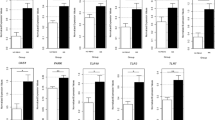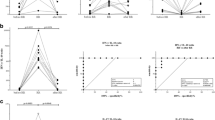Abstract
Purpose
Leprosy, a chronic disease initiated by Mycobacterium leprae, is often complicated by acute inflammatory reactions. Although such episodes occur in at least 50 % of all leprosy patients and may cause irreversible nerve damage, no laboratory tests are available for early diagnosis or prediction of reactions. Since immune- and genetic host factors are critical in leprosy reactions, we hypothesize that identification of host-derived biomarkers correlated to leprosy reactions can provide the basis for new tests to facilitate timely diagnosis and treatment thereby helping to prevent tissue damage.
Methods
The longitudinal host response of a leprosy patient, who was affected by a type 1 reaction (T1R) after MDT-treatment, was studied in unprecedented detail, measuring cellular and humoral immunity and gene expression profiles to identify biomarkers specific for T1R.
Results
Cytokine analysis in response to M. leprae revealed increased production of IFN-γ, IP-10, CXCL9, IL-17A and VEGF at diagnosis of T1R compared to before T1R, whereas a simultaneous decrease in IL-10 and G-CSF was observed at T1R. Cytokines shifts coincided with a reduction in known regulatory CD39+CCL4+ and CD25high T-cell subsets. Moreover, RNA expression profiles revealed that IFN-induced genes, (V)EGF, and genes associated with cytotoxic T-cell responses (GNLY, GZMA/B, PRF1) were upregulated during T1R, whereas expression of T-cell regulation-associated genes were decreased.
Conclusions
These data show that increased inflammation, vasculoneogenesis and cytotoxicity, perturbed T-cell regulation as well as IFN-induced genes play an important role in T1R and provide potential T1R-specific host biomarkers.




Similar content being viewed by others
References
Leprosy update, 2011. Wkly Epidemiol Rec. 2011 Sep 2;86(36):389–99.
Ridley DS, Jopling WH. Classification of leprosy according to immunity. A five-group system. Int J Lepr Other Mycobact Dis. 1966;34(3):255–73.
Massone C, Clapasson A, Nunzi E. Borderline lepromatous leprosy in an Italian man. Am J Trop Med Hyg. 2013;88(2):211.
Britton WJ, Lockwood DN. Leprosy. Lancet. 2004;363(9416):1209–19.
Lockwood DN, Suneetha L, Sagili KD, Chaduvula MV, Mohammed I, van Brakel W, et al. Cytokine and protein markers of leprosy reactions in skin and nerves: baseline results for the North Indian INFIR cohort. PLoS Negl Trop Dis. 2011;5(12):e1327.
Raffe SF, Thapa M, Khadge S, Tamang K, Hagge D, Lockwood DN. Diagnosis and treatment of leprosy reactions in integrated services—the patients’ perspective in Nepal. PLoS Negl Trop Dis. 2013;7(3):e2089.
van Brakel WH, Nicholls PG, Das L, Barkataki P, Suneetha SK, Jadhav RS, et al. The INFIR Cohort Study: investigating prediction, detection and pathogenesis of neuropathy and reactions in leprosy. Methods and baseline results of a cohort of multibacillary leprosy patients in north India. Lepr Rev. 2005;76(1):14–34.
Sarno EN, Grau GE, Vieira LM, Nery JA. Serum levels of tumour necrosis factor-alpha and interleukin-1 beta during leprosy reactional states. Clin Exp Immunol. 1991;84(1):103–8.
Stefani MM, Guerra JG, Sousa AL, Costa MB, Oliveira ML, Martelli CT, et al. Potential plasma markers of Type 1 and Type 2 leprosy reactions: a preliminary report. BMC Infect Dis. 2009;9:75.
Scollard DM, Chaduvula MV, Martinez A, Fowlkes N, Nath I, Stryjewska BM, et al. Increased CXC ligand 10 levels and gene expression in type 1 leprosy reactions. Clin Vaccine Immunol. 2011;18(6):947–53.
Moraes MO, Sampaio EP, Nery JA, Saraiva BC, Alvarenga FB, Sarno EN. Sequential erythema nodosum leprosum and reversal reaction with similar lesional cytokine mRNA patterns in a borderline leprosy patient. Br J Dermatol. 2001;144(1):175–81.
Geluk A. Challenges in immunodiagnostic tests for leprosy. Expert Opin Med Diagn. 2013;7(3):265–74.
Silva EA, Iyer A, Ura S, Lauris JR, Naafs B, Das PK, et al. Utility of measuring serum levels of anti-PGL-I antibody, neopterin and C-reactive protein in monitoring leprosy patients during multi-drug treatment and reactions. Trop Med Int Health. 2007;12(12):1450–8.
Iyer A, Hatta M, Usman R, Luiten S, Oskam L, Faber W, et al. Serum levels of interferon-gamma, tumour necrosis factor-alpha, soluble interleukin-6R and soluble cell activation markers for monitoring response to treatment of leprosy reactions. Clin Exp Immunol. 2007;150(2):210–6.
Geluk A, Bobosha K, van der Ploeg-van Schip JJ, Spencer JS, Banu S, Martins SB, et al. New biomarkers with relevance to leprosy diagnosis applicable in areas hyperendemic for leprosy. J Immunol. 2012;188(10):4782–91.
Joosten SA, Goeman JJ, Sutherland JS, Opmeer L, de Boer KG, Jacobsen M, et al. Identification of biomarkers for tuberculosis disease using a novel dual-color RT-MLPA assay. Genes Immun. 2012;13(1):71–82.
Commandeur S, van Meijgaarden KE, Prins C, Pichugin AV, Dijkman K, van den Eeden SJ, et al. An unbiased genome-wide mycobacterium tuberculosis gene expression approach to discover antigens targeted by human T cells expressed during pulmonary infection. J Immunol. 2013;190(4):1659–71.
Spaans VM, Peters AA, Fleuren GJ, Jordanova ES. HLA-E expression in cervical adenocarcinomas: association with improved long-term survival. J Transl Med. 2012;10:184.
Sahiratmadja E, Alisjahbana B, de Boer T, Adnan I, Maya A, Danusantoso H, et al. Dynamic changes in pro- and anti-inflammatory cytokine profiles and gamma interferon receptor signaling integrity correlate with tuberculosis disease activity and response to curative treatment. Infect Immun. 2007;75(2):820–9.
Berry MP, Graham CM, McNab FW, Xu Z, Bloch SA, Oni T, et al. An interferon-inducible neutrophil-driven blood transcriptional signature in human tuberculosis. Nature. 2010;466(7309):973–7.
Verreck FA, de Boer T, Langenberg DM, Hoeve MA, Kramer M, Vaisberg E, et al. Human IL-23-producing type 1 macrophages promote but IL-10-producing type 2 macrophages subvert immunity to (myco)bacteria. Proc Natl Acad Sci U S A. 2004;101(13):4560–5.
Savage ND, de Boer T, Walburg KV, Joosten SA, van Meijgaarden K, Geluk A, et al. Human anti-inflammatory macrophages induce Foxp3+ GITR+ CD25+ regulatory T cells, which suppress via membrane-bound TGFbeta-1. J Immunol. 2008;181(3):2220–6.
Joosten SA, van Meijgaarden KE, Savage ND, de Boer T, Triebel F, van der Wal A, et al. Identification of a human CD8+ regulatory T cell subset that mediates suppression through the chemokine CC chemokine ligand 4. Proc Natl Acad Sci U S A. 2007;104(19):8029–34.
Zhang L, Zhao Y. The regulation of Foxp3 expression in regulatory CD4(+)CD25(+)T cells: multiple pathways on the road. J Cell Physiol. 2007;211(3):590–7.
Cogen AL, Walker SL, Roberts CH, Hagge DA, Neupane KD, Khadge S, et al. Human Beta-defensin 3 is up-regulated in cutaneous leprosy type 1 reactions. PLoS Negl Trop Dis. 2012;6(11):e1869.
Teles RM, Graeber TG, Krutzik SR, Montoya D, Schenk M, Lee DJ, et al. Type I interferon suppresses type II interferon-triggered human anti-mycobacterial responses. Science. 2013;339(6126):1448–53.
Ottenhoff TH. New pathways of protective and pathological host defense to mycobacteria. Trends Microbiol. 2012;20(9):419–28.
Zhang FR, Huang W, Chen SM, Sun LD, Liu H, Li Y, et al. Genomewide association study of leprosy. N Engl J Med. 2009;361(27):2609–18.
Chegou NN, Black GF, Kidd M, van Helden PD, Walzl G. Host markers in QuantiFERON supernatants differentiate active TB from latent TB infection: preliminary report. BMC Pulm Med. 2009;9:21.
Friedman DJ, Kunzli BM, Rahim YI, Sevigny J, Berberat PO, Enjyoji K, et al. From the Cover: CD39 deletion exacerbates experimental murine colitis and human polymorphisms increase susceptibility to inflammatory bowel disease. Proc Natl Acad Sci U S A. 2009;106(39):16788–93.
Boer MC, van Meijgaarden KE, Bastid J, Ottenhoff TH, Joosten SA. CD39 is involved in mediating suppression by Mycobacterium bovis BCG-activated human CD8 CD39 regulatory T cells. Eur J Immunol. 2013;43(7):1925–32.
de Cassan SC, Pathan AA, Sander CR, Minassian A, Rowland R, Hill AV, et al. Investigating the induction of vaccine-induced Th17 and regulatory T cells in healthy, Mycobacterium bovis BCG-immunized adults vaccinated with a new tuberculosis vaccine, MVA85A. Clin Vaccine Immunol. 2010;17(7):1066–73.
Misch EA, Macdonald M, Ranjit C, Sapkota BR, Wells RD, Siddiqui MR, et al. Human TLR1 deficiency is associated with impaired mycobacterial signaling and protection from leprosy reversal reaction. PLoS Negl Trop Dis. 2008;2(5):e231.
Brull F, Mensink RP, Steinbusch MF, Husche C, Lutjohann D, Wesseling GJ, et al. Beneficial effects of sitostanol on the attenuated immune function in asthma patients: results of an in vitro approach. PLoS ONE. 2012;7(10):e46895.
Lee JH, Lydon JP, Kim CH. Progesterone suppresses the mTOR pathway and promotes generation of induced regulatory T cells with increased stability. Eur J Immunol. 2012;42(10):2683–96.
Ochoa MT, Stenger S, Sieling PA, Thoma-Uszynski S, Sabet S, Cho S, et al. T-cell release of granulysin contributes to host defense in leprosy. Nat Med. 2001;7(2):174–9.
Rodrigues LS, Hacker MA, Illarramendi X, Pinheiro MF, Nery JA, Sarno EN, et al. Circulating levels of insulin-like growth factor-I (IGF-I) correlate with disease status in leprosy. BMC Infect Dis. 2011;11:339.
Zhao C, Takita J, Tanaka Y, Setou M, Nakagawa T, Takeda S, et al. Charcot-Marie-Tooth disease type 2A caused by mutation in a microtubule motor KIF1Bbeta. Cell. 2001;105(5):587–97.
McLeod RS, Taylor DW, Cohen Z, Cullen JB. Single-patient randomised clinical trial. Use in determining optimum treatment for patient with inflammation of Kock continent ileostomy reservoir. Lancet. 1986;1(8483):726–8.
Acknowledgments
This work was supported by the Q.M. Gastmann-Wichers Foundation, the Netherlands Leprosy Relief Foundation (NLR) together with the Turing Foundation (ILEP#: 701.02.49), the Order of Malta-Grants-for-Leprosy-Research (MALTALEP), and the Heiser Program for Research in Leprosy in The New York Community Trust (P13-000392). The authors gratefully acknowledge patientD05 for his cooperation, Dr. B. Naafs for clinical details and critically reading this manuscript and Dr. K. Jordanova (Dept. of Obstetrics and Gynaecology, Free University Amsterdam) for expert-advice on confocal microscopy.
Conflicts of Interest
The authors declare that they have no conflict of interest.
Author information
Authors and Affiliations
Corresponding author
Electronic supplementary material
Below is the link to the electronic supplementary material.
ESM 1
(DOC 4.64 MB)
Rights and permissions
About this article
Cite this article
Geluk, A., van Meijgaarden, K.E., Wilson, L. et al. Longitudinal Immune Responses and Gene Expression Profiles in Type 1 Leprosy Reactions. J Clin Immunol 34, 245–255 (2014). https://doi.org/10.1007/s10875-013-9979-x
Received:
Accepted:
Published:
Issue Date:
DOI: https://doi.org/10.1007/s10875-013-9979-x




